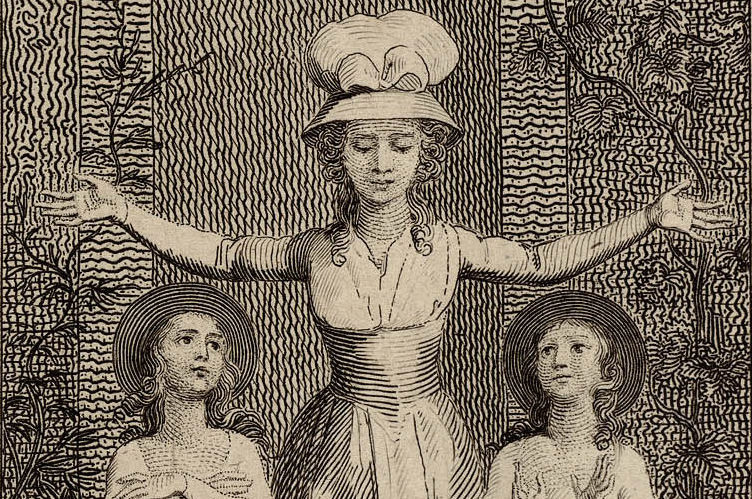Mother Market

The Rights of Women: Reclaiming a Lost Vision, by Erika Bachiochi, (University of Notre Dame Press: 2021), 422 pages.
Before abortion, before the ERA, before suffrage, feminists argued about property. Chafing under the common-law principle of coverture—by which husbands became sole proprietors of the household and its goods upon marriage—American women’s rights activists of the 1840s and ’50s called for the passage of “joint property” laws. Proposed as a resolution at the First National Women’s Rights Convention in 1850, such statutes would have made all possessions brought to marriage the property of the family unit, held “in community.” Joint property meant greater stability for women, greater buy-in to family life on the part of husbands, and social affirmation that work done in the home, rather than simply the wage labor conducted for the market, was of real value.
This was a radical proposition for a pioneer nation, that communal rather than individual property could be the norm and the family rather than the individual the foundation of a society. We took a different path. John Stuart Mill, self-proclaimed defender of women that he was, designed the family-policy proposal that American states would adopt instead in the 1870s: separate property.
Separate property offered spouses sole individual proprietorship of earnings they made outside the home. In effect, the measure promised to liberate women by making them independent market actors just like men were. Ignoring calls for social recognition of work done in the home, separate property construed the family as a free (and ultimately soluble) contract. The old patriarchal norm was successfully discarded, but in a way that made life more unstable for women and easier for the transaction of business. America’s market society and the women’s movement would exist in tension for decades thereafter.
Erika Bachiochi’s new work of intellectual and legal history, The Rights of Women: Reclaiming A Lost Vision, presents the story of feminism as a dialectic between the individualistic, acquisitive values of the marketplace and the values of care and community associated with the home. As far back as the 18th century, women’s rights advocates disagreed over how best to confront the market’s encroaching influence over public and, increasingly, private life. Did they want to change the public sphere or merely enter it on the same terms as men? Was the market’s individualism good or bad for their cause?
The Rights of Women makes clear from the get-go which side Bachiochi believes was truer to authentic feminism. The book starts with Mary Wollstonecraft, whom Bachiochi reads as a pro-family virtue ethicist. Wollstonecraft’s calls for women to share in public life and education, and for men to share in domestic life, grew out of a distinct concern that her contemporary social order was not conducive to personal development in virtue. Women could not fulfill their proper duties as human beings—true freedom, according to Wollstonecraft, belonged to “the being who discharges the duties of its station”—so long as they were kept idle and uneducated. Sounding very little like her Enlightenment contemporaries, she insisted that “a truly benevolent legislator always endeavors to make it the interest of each individual to be virtuous.”
As the story shifts to America, Bachiochi sketches the disagreement within the women’s movement over how to respond to emerging industrial capitalism. Many of the names we know today tended in the Millian direction. Elizabeth Cady Stanton aimed to win for women “freedom from all unnecessary entanglements and compulsions,” so as to attain “self-dependence, self-protection, self-support.” Charlotte Perkins Gilman went a step further. After the campaign for joint property failed, she called for the market to remake the home in its image: run by hired experts according to new principles of industrial efficiency, so that mothers could go earn a wage elsewhere. For Gilman, says Bachiochi, “no longer should the home remain an antimodern island in the industrializing sea, preserving a sphere of solidarity and kinship from market forces.”
On the other side were social reformers who emulated Wollstonecraft in one respect or another. Prohibitionist Frances Willard insisted on the importance of home life in reminding men of their duties, and encouraging public morality. Progressives like Florence Kelley and Jane Addams advocated for protective legislation for women and workers. What they had in common was an insight that the virtues of care and solidarity found in the home should be allowed to shape public life, rather than be replaced with the individualism and efficiency of the market.
This was not exactly a conservative–liberal split. One side pursued liberalization of family relationships for the sake of preserving the neutrality of law and extending economic free enterprise; the other was more conservative about family, but also more radical about economics and democracy. Nor were these strictly political movements. Intra-feminist debates over philosophical, economic, and even medical questions appear throughout The Rights of Women. Bachiochi is a legal scholar, and the second half of the book takes a more exclusive legal history approach, charting the individual careers of Ruth Bader Ginsburg and Mary Ann Glendon, especially their differences over pregnancy law and special protections for women. This comes, at times, at the cost of detail and justification for claims about other parts of feminist history. For example, Bachiochi’s assertion that, contrary to the mainstream feminist historical narrative, the “voluntary motherhood” movement of the late 19th century was anti-contraception goes without quotation from any primary sources.
But even with this narrow focus, Bachiochi does more than enough to demonstrate the breadth of the interests and ambitions of the women’s rights advocates we tend to lump together as “first wave.” A tradition within the tradition aimed at nothing less than social transformation in a pro-family, pro-child direction. These writers and activists disagreed over whether women were naturally predisposed to care and nurture, education, and religion or were simply pushed into those values by industrial capitalism, which had no use for any of it and sequestered it all with women in the “private” sphere. Nineteenth-century American women found themselves, whether by nature or nurture, to be the voice of care and solidarity in an increasingly acquisitive, competitive, materialistic society. As the market imposed itself on more and more public institutions, they represented a different set of values, a different possibility.
Abortion brought these arguments and possibilities to an abrupt halt. When second-wave feminists joined forces with the abortion legalization movement (which, until that point, was primarily a population control initiative) in the late Sixties, it had several immediate effects. For one thing, it gave up ground in the fight for women’s employment rights. “Relatively easy abortion access,” Bachiochi explains, “has made it unnecessary for businesses and other institutions in the United States to acknowledge [that] most working persons are (or ought to be) deeply encumbered by their obligations to their families.” Rather than coaxing men into sharing the duties of home life, or helping women gain employment or political influence, abortion let men off the hook and placed all the burden and the risk on women, just like the bait-and-switch of passing separate property instead of joint property had done a century earlier.
 Above all, the feminist movement, in Bachiochi’s words, “abandon[ed] the potential to disrupt the profit-oriented marketplace by calling it to a more humane, family-centered orientation.” And it’s not just feminists who privileged the individualism of the market over the solidarity of family and community. Rights of Women doesn’t claim to be a conservative book, but it renews a challenge that cuts to the heart of the conservative movement.
Above all, the feminist movement, in Bachiochi’s words, “abandon[ed] the potential to disrupt the profit-oriented marketplace by calling it to a more humane, family-centered orientation.” And it’s not just feminists who privileged the individualism of the market over the solidarity of family and community. Rights of Women doesn’t claim to be a conservative book, but it renews a challenge that cuts to the heart of the conservative movement.
Connecting the prospects for pro-family feminism with those of non-individualist conservatism, Bachiochi points to conservatives’ growing interest in family policy as a reason for hope. Child allowances and paid leave proposals are indeed appealing as a political maneuver, and probably necessary as an economic one. But the women’s rights tradition Bachiochi identifies was clearly more ambitious. “First wave” feminists were not just trying to maintain a legal carve-out for family life, or to convince the public sector to subsidize it. They were trying to re-form public life as a whole along lines that the market deemed valueless. That meant founding institutions to serve the poor, challenging the medicalization of motherhood, taking a hatchet (literally) to immoral and exploitative businesses, and—above all—demanding moral transformation across the economy and society. The market should leave the family alone, yes, but family shouldn’t leave the market alone.
Philip Jeffery is deputy opinion editor at Newsweek.